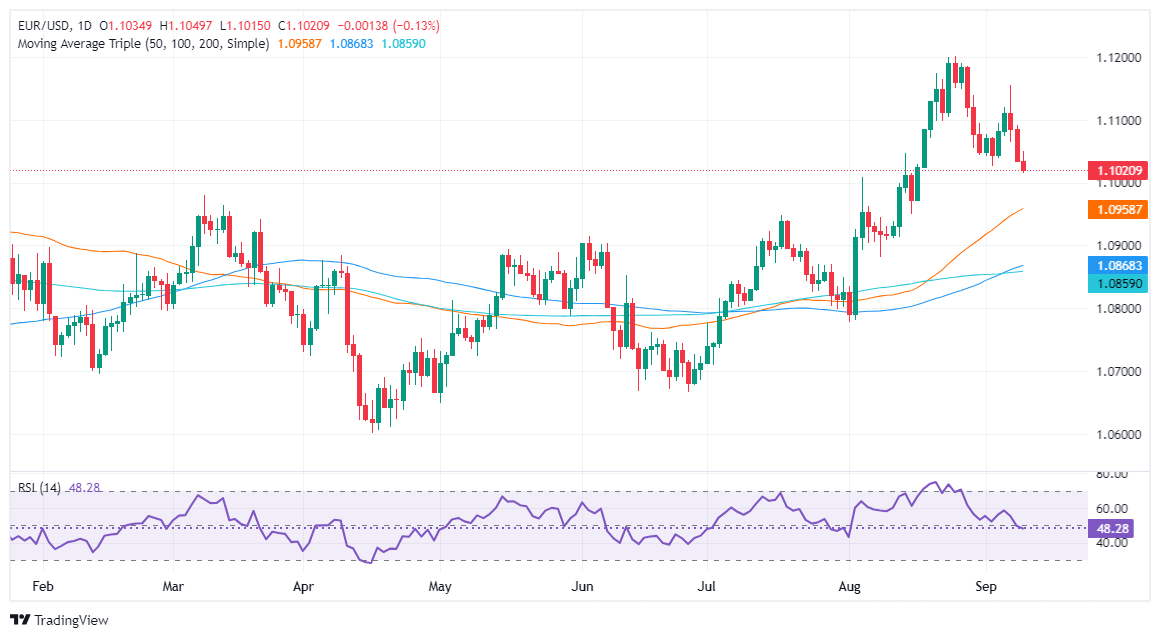EUR/USD dips as German inflation falls, ECB rate cut looms
- German HICP inflation falls to 2%, increasing the likelihood of further ECB rate cuts and downward revisions to growth forecasts.
- ECB expected to lower rates by 25 bps while maintaining a restrictive policy stance to combat inflation risks.
- US CPI data could influence Fed rate expectations, with a 70% chance of a 25 bps cut and 30% for a 50 bps cut.
The EUR/USD retreated on Tuesday after the latest inflation report in Germany, which increased the likelihood of another interest rate cut by the European Central Bank (ECB). At the time of writing, the EUR/USD trades at 1.1021, virtually unchanged, as Wednesday’s Asian session begins.
EUR/USD retreats to 1.1021 as lower German inflation fuels expectations of a 25 bps ECB rate cut on Thursday
Wall Street ended the session with decent gains, while the Greenback is almost flat. Data during the European session witnessed German inflation falling to its lowest level in over three years as the Harmonized Index of Consumer Prices (HICP) hit 2%, the ECB’s goal.
On Thursday, the ECB is expected to lower interest rates by a quarter of a percentage point, yet according to analysts at BBH, the central bank would emphasize that “it will keep policy sufficiently restrictive for as long as necessary."
Besides that, the ECB is expected to update its economic projections, which include a downward revision of economic growth and inflation. Money market traders continue to price in 50 to 75 basis points of cuts toward the end of the year.
Ahead of the week, August's US Consumer Price Index (CPI) is expected to dip towards the Fed’s 2% goal. A lower-than-expected CPI report could increase the odds of the Federal Reserve easing rates by 50 basis points, though most analysts expect the Fed to adjust policy gradually.
The CME FedWatch Tool shows that the odds for a 25 bps rate cut are 70%, while for a 50 bps rate cut, they are 30%.
EUR/USD Price Forecast: Technical outlook
From a technical standpoint, the EUR/USD remains neutral with an upward bias. However, a decisive break below the September 3 low of 1.1026 could open the door to further downside. Key support levels, such as the 1.1000 mark, will be exposed, followed by the 50-day moving average (DMA) at 1.0958. A breach of this level could lead to a test of the confluence of the 100 and 200-DMAs around 1.0867/58, before targeting the August 1 swing low at 1.0777.
For a bullish resumption, buyers would need to lift the pair above the September 9 high at 1.1091.

Euro FAQs
The Euro is the currency for the 20 European Union countries that belong to the Eurozone. It is the second most heavily traded currency in the world behind the US Dollar. In 2022, it accounted for 31% of all foreign exchange transactions, with an average daily turnover of over $2.2 trillion a day. EUR/USD is the most heavily traded currency pair in the world, accounting for an estimated 30% off all transactions, followed by EUR/JPY (4%), EUR/GBP (3%) and EUR/AUD (2%).
The European Central Bank (ECB) in Frankfurt, Germany, is the reserve bank for the Eurozone. The ECB sets interest rates and manages monetary policy. The ECB’s primary mandate is to maintain price stability, which means either controlling inflation or stimulating growth. Its primary tool is the raising or lowering of interest rates. Relatively high interest rates – or the expectation of higher rates – will usually benefit the Euro and vice versa. The ECB Governing Council makes monetary policy decisions at meetings held eight times a year. Decisions are made by heads of the Eurozone national banks and six permanent members, including the President of the ECB, Christine Lagarde.
Eurozone inflation data, measured by the Harmonized Index of Consumer Prices (HICP), is an important econometric for the Euro. If inflation rises more than expected, especially if above the ECB’s 2% target, it obliges the ECB to raise interest rates to bring it back under control. Relatively high interest rates compared to its counterparts will usually benefit the Euro, as it makes the region more attractive as a place for global investors to park their money.
Data releases gauge the health of the economy and can impact on the Euro. Indicators such as GDP, Manufacturing and Services PMIs, employment, and consumer sentiment surveys can all influence the direction of the single currency. A strong economy is good for the Euro. Not only does it attract more foreign investment but it may encourage the ECB to put up interest rates, which will directly strengthen the Euro. Otherwise, if economic data is weak, the Euro is likely to fall. Economic data for the four largest economies in the euro area (Germany, France, Italy and Spain) are especially significant, as they account for 75% of the Eurozone’s economy.
Another significant data release for the Euro is the Trade Balance. This indicator measures the difference between what a country earns from its exports and what it spends on imports over a given period. If a country produces highly sought after exports then its currency will gain in value purely from the extra demand created from foreign buyers seeking to purchase these goods. Therefore, a positive net Trade Balance strengthens a currency and vice versa for a negative balance.
